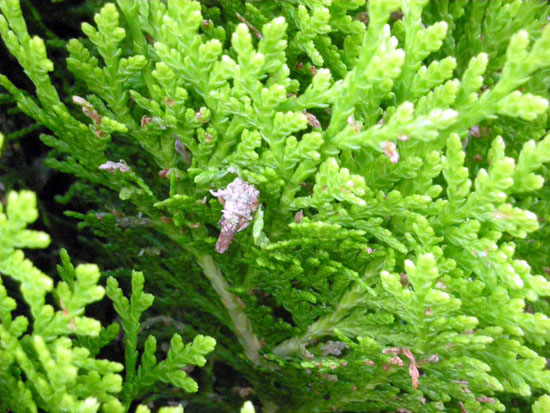Issue 6, May 31, 2016
Bagworm
Bagworms will be hatching in southern Illinois at this time. They will hatch in central Illinois by mid-June and in northern Illinois a week or two later. Upon hatching, young caterpillars crawl out of their mother's bag where the eggs were laid and crawl upward. They get to the top of the tree and spin out silk, creating a long streamer that catches in the wind, carrying the young bagworm to new hosts.
After a couple of weeks of doing little feeding and lots of ballooning, they settle down to feed in earnest. Bagworms are about one-quarter inch long with typical bags when they start feeding. Ballooning bagworms are smaller and either have no bags or conical ones that look somewhat like brown hats.
They feed from the top of the tree down, the result of still using that drive to climb to the top of wherever they find themselves. They prefer to feed on arborvitae, Eastern red cedar, other junipers, and spruce. They also feed on deciduous trees including crabapple, maple, and oak. Feeding on deciduous trees is less common as one moves north through Illinois, being common in southern Illinois, frequent in central Illinois, and scarce in northern Illinois. They are by nature polyphagous, feeding on many kinds of trees and shrubs. After all, when you are blown where the wind takes you, you better be able to eat whatever you land on.

Young bagworm on arborvitae.
Early bagworm feeding damage will appear as scarifying of the needle or leaf epidermis with internal mesophyll tissue eaten. Damaged foliage is lighter green at first and then whitish to brownish as the exposed and damaged cells die. As the bagworms get older and bigger, they eat entire leaves.
Scout for early scarifying damage at the top of susceptible hosts. It should show up in mid-June to early July, being earlier in southern Illinois and successively later as one goes north. If you wait until ballooning ends, one insecticide application will be effective. Sprays of Bacillus thuringiensis kurstaki (Dipel, Thuricide, others) and spinosad (Conserve) are effective and selective, causing less damage to pollinators and other non-pest insects. They are also organic. Other effective insecticides include cyfluthrin (Tempo), permethrin (Astro), acetamiprid (TriStar), indoxicarb (Provaunt), and chlorantroniliprole (Acelepryn). (Phil Nixon)
Author:
Phil Nixon